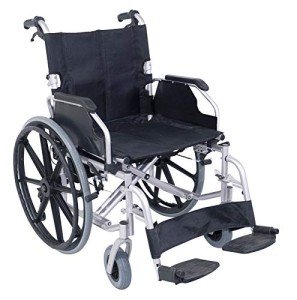Do You Think Lightweight Bariatric Transport Wheelchair One Day Rule The World?
Bariatric Transport Wheelchair Developed to be pushed by caregivers, transport chairs include smaller sized front wheels and larger rear wheels. simply click the following site are a popular choice for users with minimal mobility who can not stroll individually. When looking for a lightweight bariatric transport wheelchair, think about the user's needs and how they'll use the chair. Likewise, determine any doorways and other areas the chair will travel through. Seating Bariatric transport chairs feature a large 22 to 36 inch large seating area that accommodates extra-large users. The chair seat is made from breathable nylon and features padded arms that can be removed and swing-away footrests. Unlike basic wheelchairs, which are ideal for typical body weights, bariatric chairs have heavier frames constructed from enhanced products and bigger rear wheels that make it simpler to press them. Talk with a mobility expert to find out more about your alternatives and to determine which type of wheelchair is best for you. Bariatric wheelchairs are often covered by insurance suppliers like Medi-Cal if your medical condition satisfies their coverage criteria. Frame Bariatric transport wheelchairs use heavy-duty frames made from reinforced materials like steel and have wider seats than standard wheelchairs. They are designed for people with higher body weights and can hold an optimum weight capacity of 700 pounds. They also have larger rear wheels, that make them much easier for caregivers to push. Bariatric wheelchairs are often covered by insurance such as Medi-Cal, depending upon the client's specific medical requirements and medical diagnosis. Ask a healthcare professional or mobility professional to help choose the best chair for your distinct requirements. Click here for more information. Medline Bariatric Transport Chair. Deep Red Hammertone Frame. Weight While basic wheelchairs have lighter frames and smaller wheels, bariatric transport chairs include heavier-duty materials and a larger seat to accommodate users who weigh more than average. Since of their specialized style and building and construction, they tend to cost more than standard chairs. Nevertheless, some insurance programs like Medicare and Medi-Cal might cover the expense of these chairs if the user meets the criteria for coverage. To find out more about which chair is right for you, call a rehabilitation expert today. Wheels Bariatric transport wheelchairs have larger rear wheels than standard models, making them simpler to push. They're often utilized in hospitals and home settings, where the chair is pushed by caretakers. The extra-large rear wheels also enable the chairs to browse a variety of surface, consisting of outdoors. Standard wheelchairs usually have smaller sized wheels, which make them more maneuverable inside but less appropriate for daily use on outdoor streets and other surface areas. Mobility specialists suggest speaking with a healthcare service provider or mobility specialist to pick the finest wheelchair for your specific requirements and objectives.  This sturdy, nylon reinforced steel transport chair supports clients as much as 500 pounds and includes a roomy 22” seat, padded desk-length armrests, swing-away footrests and hand brakes. The 12-inch rear wheels make sure a smooth ride in any environment.
This sturdy, nylon reinforced steel transport chair supports clients as much as 500 pounds and includes a roomy 22” seat, padded desk-length armrests, swing-away footrests and hand brakes. The 12-inch rear wheels make sure a smooth ride in any environment.